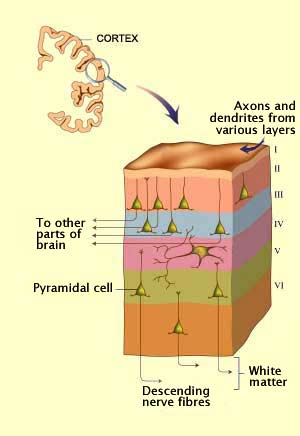
CORTICAL LAYERS
The human cerebral cortex is composed of two principle types of neurons:
- ► Stellate cells have spheroidal somas (cell bodies) with dendrites projecting a short distance in all directions. These cells are primarily concerned with processing information on a local level and receiving sensory input.
► Pyramidal cells are tall and conical. These cells transmit signals to other parts of the CNS. Their axons have collaterals that synapse with other neurons in the cortex or in deeper regions of the brain.
Around 90% of the cerebral cortex is a six layered tissue called the neocortex (neo meaning new due to its relatively recent evolutionary origin). The neocortex is involved in higher functions such as the generation of motor commands, sensory perception, conscious thought, spatial reasoning and language.
The Cortical Layers of the Neocortex
The six layers of the neocortex, numbered I to VI in the figure below, vary from one part of the cerebrum to another in relative thickness, cellular composition, neuronal size and axonal destination. For example, layer IV is thickest in sensory regions and Layer V is thickest in motor regions.
Cortical areas that lack a layer IV are known as agranular, and areas that only have a very basic layer IV are called dysgranular.
Cortical Layers of the Neocortex. Image courtesy of The Brain from Top to Bottom taken with permission under Copyleft. This image is public domain.
- I. Molecular layer, the most superficial layer. Contains few scattered neurons.
II. External Granular Layer, contains small pyramidal cells and numerous stellate cells.
III. External Pyramidal Layer, predominantly made up of small and medium sized pyramidal neurons, as well as non-pyramidal neurons with vertically-oriented intracortical axons.
IV. Internal Granular Layer, contains different types of pyramidal and stellate cells.
V. Internal Pyramidal Layer, contains large pyramidal neurons.
VI. Multiform Layer, contains a few large pyramidal neurons and many small spindly-like pyramidal and multiform neurons.
Despite what many think, the cortical layers are not simply stacked one on top of the other in the cortex. Characteristic connections exist between different layers and neuronal types which can cover the entirety of the layers. These are called cortical microcircuits and are grouped in cortical columns and minicolumns; the minicolumn has been thought of by some as the basic functional unit of the cortex.
All axons that leave the cortex and enter the white matter originate from layers III, V, and VI.
Some areas of the cerebral cortex contain less than six layers but the neocortex always contains six.
Neocortex Ratio
The neocortex ratio is the ratio of the size of the neocortex to the rest of the brain. This ratio differs from species to species and a high neocortex ratio is suspected to have correlation with a number of social variables, e.g. the size of social groups and the complexity of social mating behaviour.
The Paleocortex and the Archicortex
The paleocortex was the earliest type of cerebral cortex to appear in vertebrate evolution. It is a one- to five-layered tissue limited in humans to part of the insula and certain areas of the temporal lobe concerned with smell.
The archicortex was the next layer to evolve. It consists of three layers and is found in the human hippocampus.

